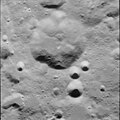 LRO image | |
| Coordinates | 3°54′N175°30′W / 3.9°N 175.5°W |
|---|---|
| Diameter | 59 km |
| Depth | Unknown |
| Colongitude | 176° at sunrise |
| Eponym | Feodosiy N. Krasovskiy |


Krasovsky is an impact crater on the far side of the Moon. It is located about three crater diameters to the north-northwest of Daedalus. It is otherwise relatively isolated from impact craters of note, with the nearest comparable feature being Tiselius to the west-northwest.
The rim of this crater is relatively well-defined, and has not suffered significant impact erosion. Within the interior floor is a central peak that is offset slightly to the west of the midpoint. There are no notable craters along the rim or within the interior.
One of the faint extremities of the ray system belonging to Jackson passes less than half a crater diameter to the west of Krasovsky. The ray originates to the north-northeast.



